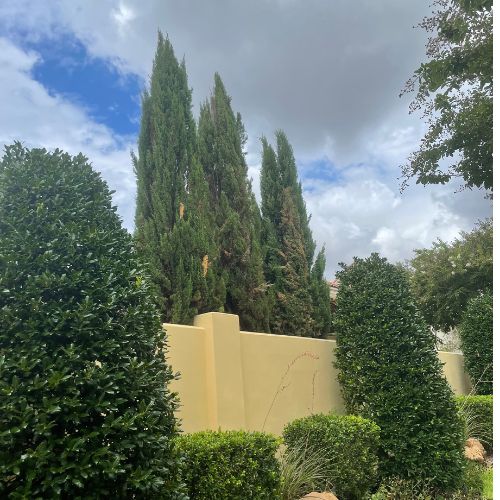Do you have Evergreen, oak, or perhaps cedar trees in your yard that have sacs on the branches? What you are actually seeing is cone-shaped cocoons that host bagworms. Bagworms are insects that infest trees like oak and cedar trees, but primarily make their homes and eat the foliage of Evergreen trees and arborvitae shrubs. Homeowners and business owners tend to not notice them until they see defoliation to the tree. If you have just noticed that your trees are infested with bagworms, call Fort Worth Arborist Co. today at 817-975-0180 for professional bagworm treatment in Fort Worth, TX. We are able to remedy the situation before the bagworms destroy your beautiful trees.

For 20 years, we’ve been Fort Worth’s leading company for Bagworm Treatment.
Just call us at 817-975-0180

We know how much time and work is put into landscaping homes and businesses, so if you find your trees or shrubs infested with bagworms, you can rely on us for quality and effective bagworm treatment for your Fort Worth, TX property. We will be able to determine if the larvae have hatched already or if they are still in their cocoons, which will give us a better idea of what treatment plan to go with. Call us at 817-975-0180 to make an appointment for sick tree help today!
Us
Them
The most effective ingredient for killing bagworms is Bacillus thuringiensis (Bt), a natural soil-dwelling bacterium. Insecticides containing permethrin or spinosad are also effective against bagworms and are commonly used in treatments.
Bagworms are a significant problem because they feed on the leaves of trees and shrubs, potentially defoliating and even killing them if left unchecked. They primarily affect evergreen trees and can cause extensive damage to landscapes and natural environments.
A natural spray for bagworms can be made using Neem oil, a botanical pesticide derived from the Neem tree. Mixing Neem oil with water and spraying it directly onto the bagworms and affected plants can disrupt the insects’ feeding and reproduction, providing a natural method of control.
Bagworms are recognized by the distinctive spindle-shaped bags they create from silk and bits of leaves or twigs. These bags, which can be up to 2 inches long, camouflage and protect the larva as it feeds. The larvae themselves are caterpillar-like, with brown or black bodies.
Preventing bagworms involves regular inspection of susceptible trees and shrubs, particularly from late spring to early summer when bagworms are most active. Removing and destroying the bags before larvae hatch in late spring is a key preventative measure.
The best time to spray for bagworms is in late spring or early summer when the larvae are small and actively feeding. This timing ensures that treatments are more effective, as the larvae are more vulnerable to insecticides before they create their protective bags.
The life cycle of a bagworm includes egg, larval, pupal, and adult stages. Females lay their eggs inside the bag in fall, where they overwinter and hatch the following spring. The larvae then feed and create their own bags, pupating inside them before emerging as adults in late summer. Males are moth-like and fly to find a mate, while females remain wingless and inside their bag.